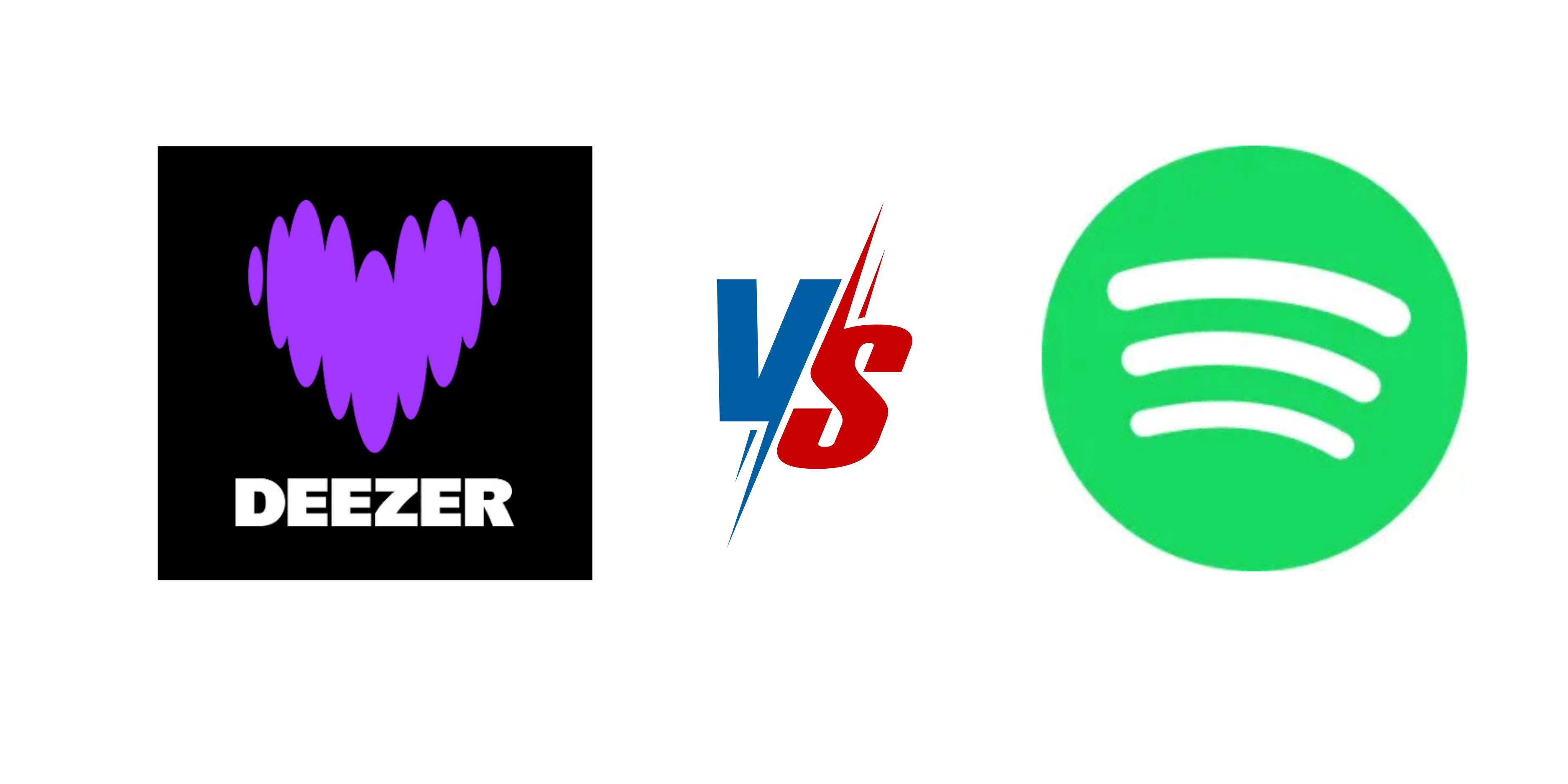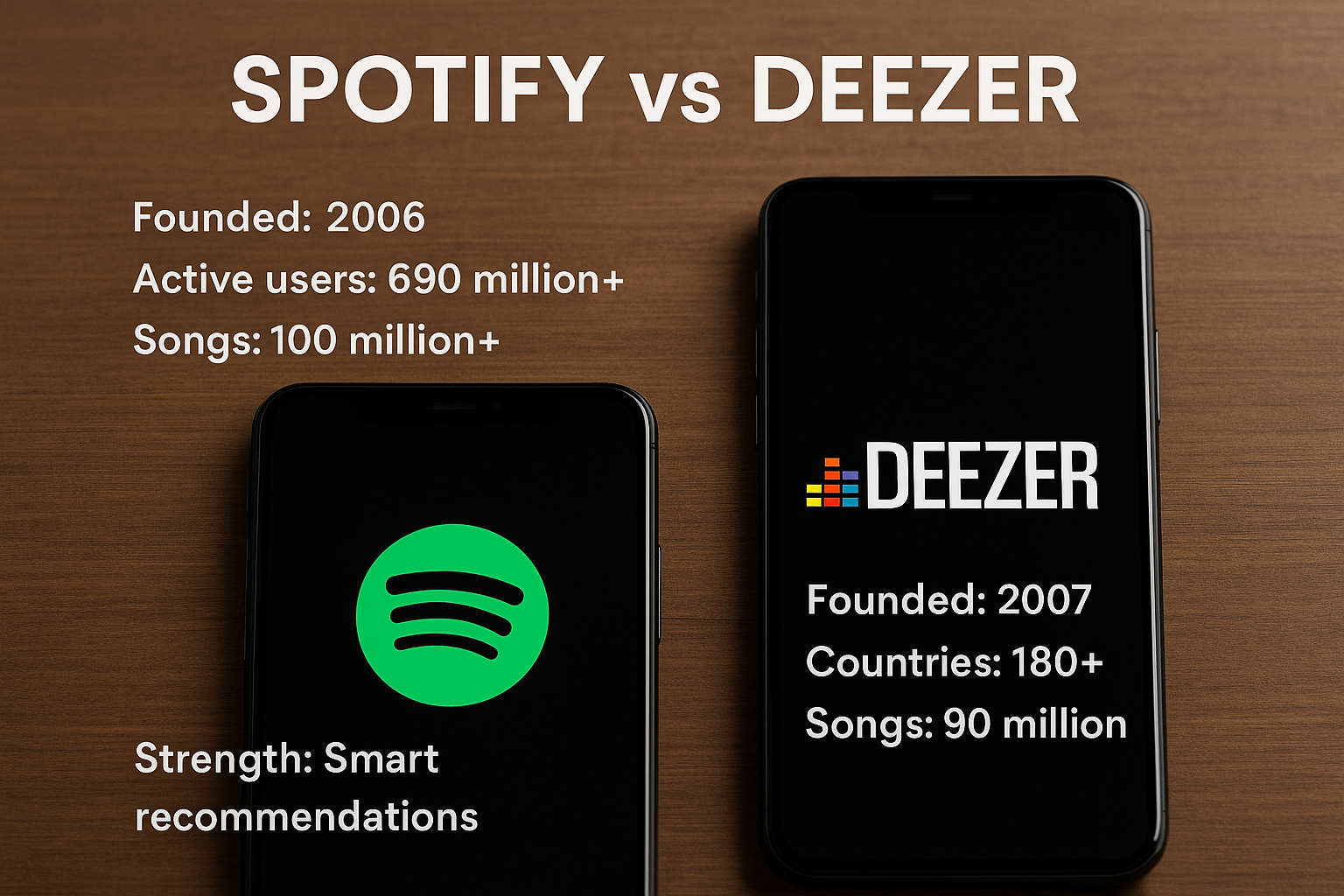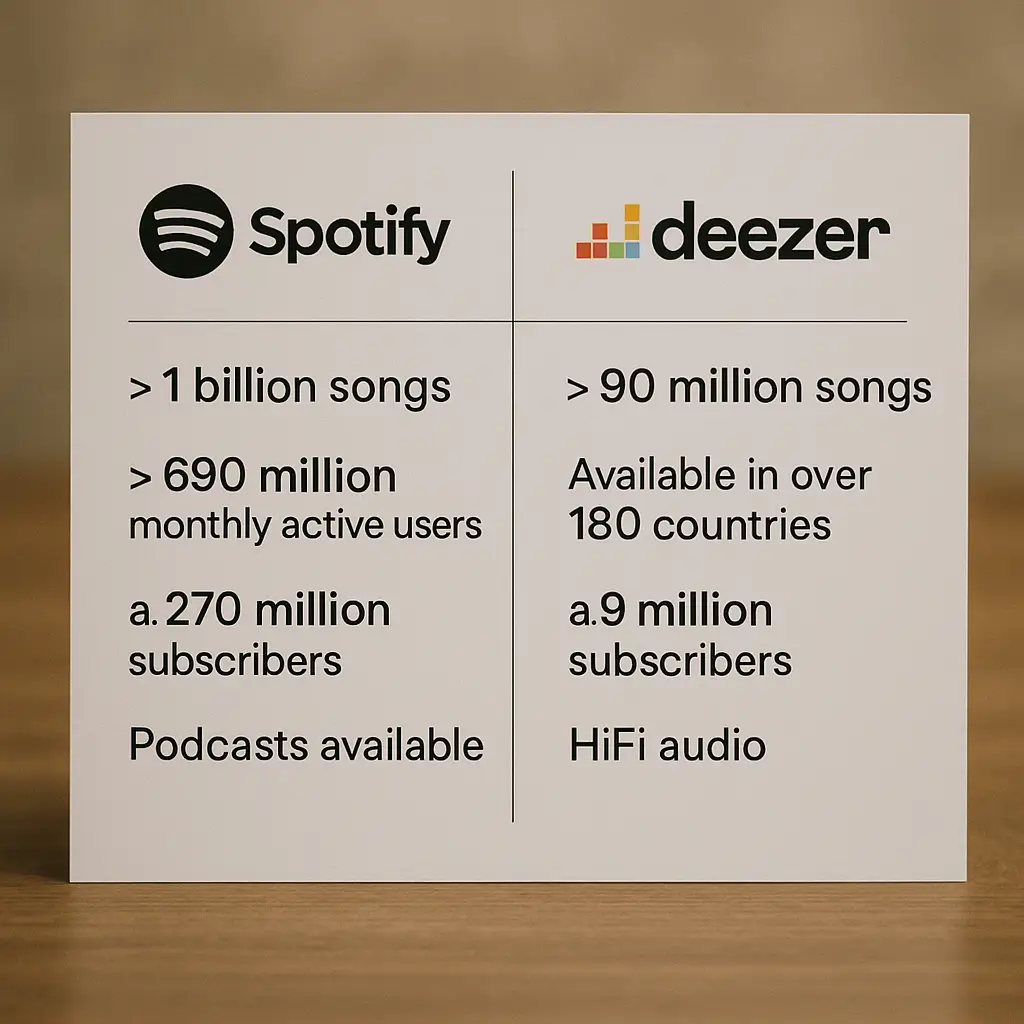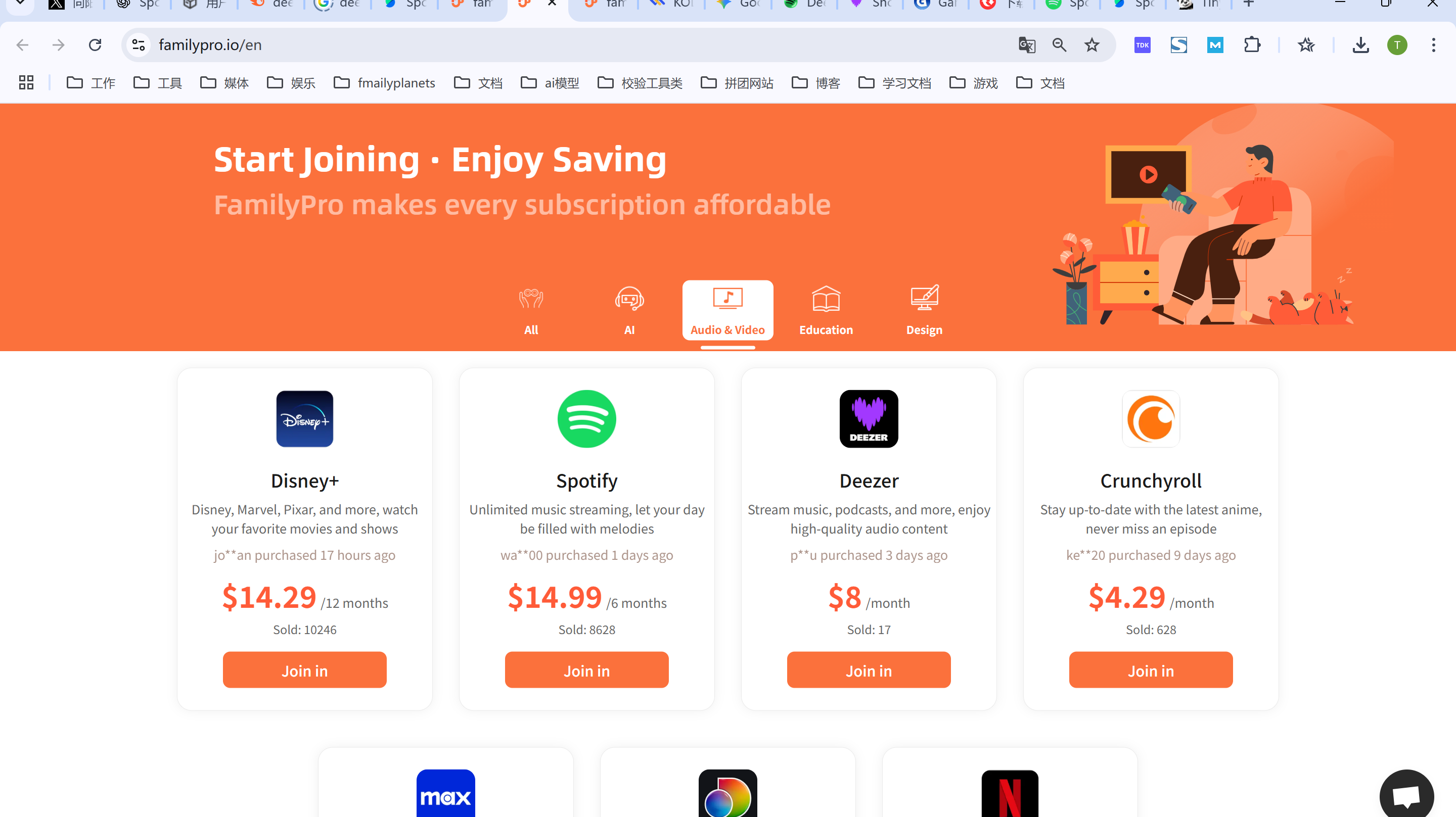Deezer vs Spotify: Which One’s Right for You?

When it comes to music streaming apps, Spotify and Deezer are undoubtedly two major players you can’t ignore. One is the global leader with incredible recommendation algorithms and impressive social features; the other focuses on lossless audio quality, offering a clean, minimalist design that audiophiles absolutely love. So which one should you choose?
This question is like asking "do you prefer hustle and bustle or peace?" – there’s no one-size-fits-all answer. Some people love the thrill of intelligent recommendations bringing pleasant surprises. In contrast, others care more about whether the audio quality can bring them happiness. So today, we’ll dive deep into audio quality, music libraries, features, and pricing to help you find the perfect match.
Platform Overview
To compare Spotify and Deezer effectively, we first need to understand what each platform has to offer.

Spotify, the Swedish giant that started making waves in 2006, now boasts 690 million monthly active users, with 270 million of them being paid subscribers. Their music library contains over 100 million tracks, and they're also killing it in the podcast game. Their secret weapon? The "Discover Weekly" feature that somehow always knows exactly what you want to hear before you even know it yourself – it's like having a mind reader as your personal DJ.
Deezer, based in Paris, France, was launched in 2007 and serves 180 countries with a library of 90 million songs. While they may not have Spotify's user numbers, they have one killer feature: Hi-Fi lossless audio quality. For those "no lossless, no listen" audiophiles, this is pure heaven. Plus, their Flow feature is incredibly thoughtful – like having your own personal DJ who always knows your mood.
Simply put, Spotify feels more like a bustling music community where everyone discovers, shares, and discusses together; Deezer is more like a high-quality music companion that quietly accompanies you while you enjoy great music.
Deezer vs. Spotify: Core Features Showdown
Audio Quality: Where Deezer vs Spotify Shows the Biggest Difference
Among all comparison points, audio quality is the most significant differentiator between Spotify and Deezer.
Spotify offers up to 160 kbps streaming quality for free users. In comparison, Premium subscribers can enjoy up to 320 kbps in Ogg Vorbis or AAC format. This level is perfectly adequate for most users’ daily needs, especially during commutes or when using Bluetooth headphones. However, Spotify currently doesn’t offer true lossless audio quality. Although the company has repeatedly mentioned the upcoming "Spotify HiFi" service, it has yet to launch officially.
Deezer offers a broader range of audio quality options. The free version offers around 128 kbps, while the paid version not only provides 320 kbps standard quality but also includes Hi-Fi-level FLAC lossless audio (16-bit/44.1kHz) with bitrates up to 1,411 kbps. On high-quality headphones or audio systems, Deezer can deliver richer details, a more expansive soundstage, and a more authentic dynamic performance.
If you typically use regular headphones, the difference between the two won't be particularly noticeable. However, if you have decent audio equipment or are particularly sensitive to sound quality, Deezer's advantages become readily apparent.
Deezer vs Spotify Music Library and Content Richness
Besides audio quality, library size, and content diversity are also crucial indicators for measuring a music streaming platform.

Spotify currently leads in library size, with over 100 million songs, and continues to expand. Through partnerships with major global record labels and independent artists, almost all popular musicians and mainstream albums are available on Spotify from day one. Additionally, Spotify has a significant advantage in podcast content, having built a massive content ecosystem. Whether it's globally renowned shows or independent creators’ work, users can find everything on the platform, making Spotify unique in providing a comprehensive "music + podcast" experience.
Deezer’s library contains nearly 90 million songs, which isn’t far behind Spotify. More importantly, it has obvious content advantages in European markets, particularly in France, with a rich independent music scene and localized content. For users who want to explore music from different cultural backgrounds, Deezer offers more opportunities. Additionally, Deezer maintains radio channels, audiobooks, and other diverse content, making its “beyond music” listening experience more comprehensive.
Regarding regional availability, both platforms face situations where certain artists or albums are only available on specific platforms or in certain countries due to licensing issues. For example, some prominent Western artists’ new albums may launch on Spotify first. At the same time, specific European independent musicians prefer to release their work on Deezer. For users, this means that despite similar library sizes, you might still encounter situations where “your favorite song is available on one platform but missing on another.”
Looking at independent and niche music coverage, Deezer stands out more. It offers a rich selection of electronic, jazz, world music, and other genres, catering to users with diverse musical tastes. Meanwhile, Spotify maintains strong market appeal with mainstream pop content and exclusive podcasts.
Deezer vs Spotify Music Recommendations: Two Different Philosophies
In streaming platforms, personalized recommendations have become a core competitive advantage. They not only influence what you listen to daily but also directly determine whether "you're willing to stay on this platform long-term."
Spotify's advantage here is truly industry-leading. Their recommendation system relies on massive user data and algorithmic models. From your very first song play, the platform continuously records your listening habits, skip behaviors, and preferences, etc., and generates personalized playlists accordingly. For example:
- Discover Weekly updates automatically every Monday, recommending 30 songs you probably haven't heard but might love;
- Release Radar collects new releases from artists you follow or genres you frequently listen to.
- Daily Mix automatically generates multiple mixed playlists based on different styles, suitable for various scenarios.
- Plus newer features like AI DJ and Daylist that can even "talk" like radio hosts and introduce songs.
This system's most prominent feature is "active exploration" – you're constantly guided to discover new music, perfect for users who love trying new things and enjoy refreshing their listening experience regularly.
In contrast, Deezer's recommendation system is more straightforward and intuitive, with a "you listen, I understand" approach. Their core feature, Flow, can be seen as an "infinite playlist" based on your past listening habits and favorites. You need one click to start an ever-extending personalized music journey without having to select, filter, or adjust anything. For users who don't want to spend time managing playlists and want to "click and listen," Flow is like a personal DJ who always understands your mood.
Additionally, Deezer offers Flow Moods and Track Mix features, allowing users to choose different Flow modes based on mood, style, or rhythm, like "Chill," "Focus," "Happy," etc. Their recommendations don't prioritize "discovering new content" first, but rather focus on "matching your current state," keeping you immersed in the right atmosphere.
Deezer vs Spotify Interface Design: Bustling vs. Minimalist
For a music streaming platform, interface design and user experience have a direct impact on user retention. After all, most people open these apps several times a day, and if the operation is cumbersome or the interface is cluttered, even the best library and audio quality won’t keep users engaged.

Spotify's interface is the "all-in-one" type, cramming almost every conceivable feature into one app: music playback, podcasts, playlist recommendations, social feeds, AI DJ... The modules are incredibly rich. Its advantage lies in the one-stop experience – you don't need to download additional apps to enjoy the complete service. However, the downside is that for first-time users, the interface can feel information-heavy with many buttons and entry points, sometimes appearing complex. Especially when you want to listen to music quickly but are bombarded with podcast recommendations, suggested playlists, or even ads, it can feel overwhelming. In other words, Spotify's experience better suits people who enjoy "exploring" within the app.
Deezer's interface takes an entirely different approach – its keyword is "simplicity." Opening the homepage, recommended content is limited, and core operations basically focus on "play" and "discover." For users accustomed to "click and listen," this design feels more intuitive. Take the Flow feature, for example – it takes almost just one click to start playing music that suits you, without having to pick and choose from numerous playlists. This makes Deezer's user experience feel lightweight and more suitable for listeners who want to focus entirely on the music itself.
From a visual design perspective, Spotify leans toward content stacking, emphasizing richness and variety. At the same time, Deezer focuses more on white space and clarity, emphasizing focus and intuition. Their differences somewhat reflect their positioning: one is a feature-rich "music community," the other is a pure "music companion."
Deezer vs Spotify: Each Platform's Killer Apps
While mainstream features don't differ much between Spotify and Deezer, their "exclusive features" show distinct approaches, and these small highlights often become key factors in users' long-term platform choices.
Spotify's exclusive features mainly focus on "interactivity" and "content integration." For example, their Collaborative Playlists allow multiple people to jointly edit the same playlist, making them perfect for couples, friends, or teams. The Group Session feature enables users to sync their listening to the same song in real-time, even when they are apart, creating a "cloud listening party" atmosphere. Additionally, Spotify has made a deep investment in podcasts for years, signing exclusive content from creators like Joe Rogan, making it not just a music platform but a comprehensive audio entertainment platform. Worth mentioning is Spotify's recently launched AI DJ feature, which can "talk" like a radio host, introducing songs and recommending new content, making music playback more personalized.
Deezer's exclusive features lean more toward "enhancing music experience." Most notable is SongCatcher, Deezer's built-in song identification tool that can directly replace Shazam. Users need to open Deezer to instantly identify songs playing nearby and save them with a single click – a convenient feature. Another standout feature is synchronized lyrics, which provide a karaoke-style word-by-word display during playback, making it especially friendly for users who love singing along. Additionally, Deezer's Flow and Track Mix features not only generate infinite personalized playback but can also subdivide different atmospheres based on mood and scenario, providing more immersive experiences. Notably, some library content also supports 360 Reality Audio, providing users with immersive surround sound effects.
Deezer vs Spotify: Social Features Compared
In streaming platform competition, music itself is certainly important, but "how to share music with others" is equally crucial. For many young users, music isn't just personal entertainment but an integral part of social interaction.
Spotify excels in this area. It provides complete social functions within the app, such as:
- You can follow friends, see what they’re currently listening to, and even directly play friends’ current tracks.
- Through Collaborative Playlists, you and your friends can jointly create and edit playlists, with everyone able to add or remove songs – perfect for parties or couples sharing.
- Group Session goes further, allowing you and your friends to sync up and listen to the same song in real-time, even when not in the exact location, instantly maximizing the social atmosphere.
For sharing channels, Spotify also deeply integrates with mainstream social media. You can share currently playing songs or playlists to Instagram Stories, Snapchat, or Facebook with one click, making music a common topic in your social circle. This intense "community atmosphere" not only increases user stickiness but makes Spotify the central platform for many people's music social life.
Compared to Deezer's social features, those of Spotify are much more prominent. It certainly supports sharing song links to WhatsApp, Facebook, or Instagram, but overall feels more like an "additional feature" rather than a core selling point. Deezer focuses more on personalized experiences, such as utilizing the Flow feature to cater to your listening needs, rather than encouraging frequent interaction with others. For many users, this "weak social" design actually better fits their needs: music is personal enjoyment time that doesn't need interruption.
Spotify vs Deezer: Pricing Comparison and Value
Besides features and experience, pricing is often the key factor in users’ final choices.
Free Plans Compared
Spotify Free is how many people first encounter Spotify. Its advantage lies in fully open recommendation features – even free users can experience Discover Weekly, Release Radar, and other personalized playlists. However, limitations are equally obvious:
- Maximum 160kbps audio quality;
- Mobile users can only shuffle-play playlists, not freely select songs.
- Limited skips (usually 6 per hour);
- Frequent ad interruptions affect immersion.
- No offline listening.
Compared to Deezer Premium, Deezer Free has slightly less restrictive terms. It also includes ads and features an audio quality of around 128 kbps, but mobile restrictions on song selection are less stringent than those of Spotify. Users can still access the Flow feature to directly start personalized playback, providing a smoother experience for those who prefer "easy click and listen." However, like Spotify, offline listening requires a subscription to unlock.
Overall, Spotify's free version feels more like a "trial experience" to attract users to upgrade to Premium. In contrast, Deezer's free version is closer to actual usage scenarios, offering a relatively complete listening experience even without a paid subscription.
Paid Plans Compared
Paid versions show more obvious differences between the two.

Spotify Premium offers multiple subscription plans:
- Individual: Around $11.99/month;
- Duo: Around $15.99/month;
- Family: Around $19.99/month, supporting six accounts;
- Student: Around $5.99/month, best value.
After subscribing, users enjoy ad-free playback, unlimited skips, offline listening, and high-quality audio up to 320kbps. However, note that Spotify's "HiFi" or "Music Pro" lossless audio quality hasn't officially launched yet and might become an additional paid feature in the future.
Deezer Premium pricing is similar to Spotify:
- Individual: Around $11.99/month;
- Family: Around $17.99/month, supporting six accounts;
- Student: Around $5.99/month.
Unlike Spotify, Deezer Premium already includes HiFi lossless audio quality at no extra cost. For users prioritizing audio quality, this makes Deezer a more cost-effective option.
Save Money with FamilyPro

When choosing between Spotify and Deezer, besides comparing features and audio quality, pricing is often users’ most significant concern. For those who want to subscribe to Premium, the official pricing, which is around $10-12 monthly, adds up to a substantial annual expense. This is where FamilyPro provides a more economical solution.
Unlike traditional “family plan sharing,” FamilyPro uses a top-up model. Specifically, users only need to provide their commonly used email address, and the platform will directly top up Spotify or Deezer membership at discounted wholesale prices. After completing the top-up, your account becomes a complete Premium account with identical functionality to official subscriptions: ad-free playback, unlimited skips, offline listening, and Deezer’s HiFi lossless audio quality.
This approach’s most significant advantage is that your account remains independent – no need to share with strangers or worry about being kicked out of a “family group.” Since FamilyPro has stable procurement channels, top-up prices are typically 30%-60% cheaper than official rates, providing significant long-term savings. If you’re using Spotify Premium for the first time, check out our detailed tutorial: How to Get Spotify Premium, which includes detailed operation steps.
Of course, such services have considerations: prices may fluctuate with exchange rates or channel costs; users should choose reputable platforms to avoid unstable or unofficial “black account top-ups.” For security reasons, we also recommend learning how to change your Spotify account password to protect your account. Overall, FamilyPro’s top-up model is more convenient and safer than group sharing.
Deezer vs. Spotify: Which Should You Choose?
If you're still hesitating, think about it this way:
👉 Better suited for Spotify: You love constantly discovering new songs, enjoy sharing playlists with friends or even listening together remotely, also listen to podcasts, and treat music as part of your lifestyle. Spotify is like a bustling music plaza, where new content is always waiting to be explored.
👉 Better suited for Deezer: You’re picky about audio quality and want to hear HiFi lossless; you don’t like spending time selecting songs and prefer clicking to get a Flow that understands you; or you prefer quietly enjoying music alone. Deezer is like a personal music companion – quiet but understanding, and often more budget-friendly.
So the answer is straightforward:
- If you value "social + discovery" more, choose Spotify;
- If you value "audio quality + immersion" more, choose Deezer.
However, regardless of your final choice, you can obtain a Premium membership at a lower price through FamilyPro. Their top-up model directly charges official membership fees to your email account, providing complete functionality identical to official websites, but at prices often 30%-60% cheaper. In other words, whether you want Spotify’s bustling community or Deezer’s high audio quality, FamilyPro can help you get the complete experience more affordably.
Frequently Asked Questions
1. When will Spotify HiFi be released?
Spotify announced HiFi plans in 2021, promising CD-quality audio, but hasn’t confirmed a specific release date yet. The company says it’s still in development but hasn’t provided a clear timeline. If you urgently need HiFi quality, consider Deezer, Apple Music, or Amazon Music HD, which already offer this feature.
2. Which service uses more data?
Deezer HiFi uses approximately 1.4GB per hour due to its lossless format, nearly 10 times more than Spotify Premium (about 144 MB per hour). Using HiFi services on mobile networks requires attention to data consumption – recommend using WiFi or downloading content locally in advance. Standard quality modes have similar data consumption across platforms.
3. Can both Deezer and Spotify work offline?
Yes, all mainstream paid music services support offline listening. You can download songs to your device when connected to the internet, then play them normally in offline environments. Usually, each account has download limits (such as 10,000 songs), which are sufficient for daily needs. Offline functionality is handy for commuting and travel scenarios.
4. Which has better audio quality?
Deezer’s HiFi plan offers the best audio quality experience, supporting CD-quality lossless audio (1411 kbps FLAC format). Spotify Premium is limited to 320kbps, which, although adequate for most users, still reveals noticeable differences compared to lossless formats. Use high-end headphones or audio systems and care about audio detail. Deezer HiFi will bring richer listening layers and more accurate sound reproduction.
5. Is it worth switching from Spotify to Deezer?
This depends on your core needs. If audio quality is your primary consideration and you have playback equipment that can showcase quality differences, switching to Deezer HiFi is a wise choice. If you value a platform ecosystem, integration with other apps, and familiar recommendation algorithms, continuing with Spotify might be more suitable. We recommend trying Deezer’s free version or short-term subscription first, comparing the actual usage experience before deciding.
6. Which service is better for discovering new music?
Both platforms excel at music discovery, but in different ways. Spotify’s algorithmic recommendations are more diverse, providing personalized suggestions through Discover Weekly and Daily Mix, which are good at uncovering different music styles. Deezer’s Flow feature focuses more on continuity, seamlessly mixing songs you love with similar new music, creating a more natural discovery experience.
7. Can I use both services simultaneously?
Technically, it’s entirely feasible, but economically costly. Simultaneously subscribing to the premium versions of Spotify and Deezer costs approximately $24 per month. A more reasonable approach is to choose a primary platform based on your needs, while occasionally using the free versions of other services. For family users, consider family plans for lower average costs. You can get low-price top-ups for your accounts through FamilyPro.
8. Does FamilyPro automatically charge fees?
No, FamilyPro currently only supports one-time payments. When benefits expire, there’s no automatic renewal charge.